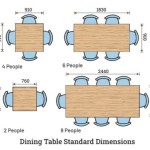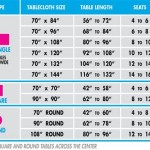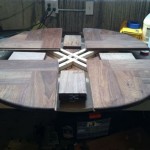What Size Patio Umbrella For a 48-Inch Round Table
Selecting the appropriate patio umbrella size for a 48-inch round table involves several considerations beyond mere aesthetics. The primary goal is to provide adequate shade, ensuring comfortable seating and protection from the sun's harmful ultraviolet rays. A properly sized umbrella enhances the functionality and overall enjoyment of an outdoor dining or relaxation area. This article presents a comprehensive guide to choosing the ideal umbrella size, taking into account factors such as table size, desired shade coverage, umbrella type, and potential environmental conditions.
The general principle guiding umbrella selection is that the umbrella canopy should extend beyond the table's edge on all sides. This overhang provides shade for individuals seated around the table. Insufficient shade coverage renders the umbrella ineffective, while an excessively large umbrella can appear disproportionate and potentially be more susceptible to wind damage. Therefore, a balanced approach is crucial.
Determining Minimum Umbrella Size
A fundamental starting point is determining the minimum umbrella size required to provide adequate shade for a 48-inch round table. The following calculation serves as a practical guideline:
1.
Table Diameter:
The table is 48 inches in diameter.2.
Desired Overhang:
A minimum overhang of 12 inches on each side is generally recommended. This means the umbrella canopy should extend at least 12 inches beyond the table's edge.3.
Calculate Total Diameter:
Add the desired overhang to both sides of the table diameter (12 inches + 12 inches = 24 inches). Then add this result to the table diameter: 48 inches + 24 inches = 72 inches.Therefore, a 72-inch umbrella represents the absolute minimum size for a 48-inch round table. However, this calculation assumes ideal conditions with the sun directly overhead. In reality, the sun's angle changes throughout the day, influencing the effective shade coverage.
To account for variations in the sun's angle, opting for a slightly larger umbrella is generally advisable. A 7.5-foot (90-inch) or even a 9-foot (108-inch) umbrella can provide significantly better shade coverage, particularly during early morning and late afternoon hours when the sun is lower in the sky.
It is important to note that these calculations provide a baseline. Personal preferences regarding shade coverage should also be considered. Some individuals prefer more extensive shade, while others may be content with minimal protection from the sun.
Factors Influencing Optimal Umbrella Size
While the minimum umbrella size can be calculated based on table diameter and desired overhang, several other factors should be considered to determine the optimal umbrella size for a 48-inch round table. These factors include table placement, umbrella type, and wind conditions.
Table Placement:
The location of the table relative to the sun's path is a crucial consideration. If the table is situated in an area that receives direct sunlight throughout the day, a larger umbrella is generally recommended. Conversely, if the table is partially shaded by trees or buildings, a smaller umbrella might suffice.
Umbrella Type:
The type of umbrella also influences the optimal size. Market umbrellas, which are the most common type, feature a central pole and a traditional canopy design. Cantilever umbrellas, also known as offset umbrellas, have a supporting pole positioned to the side of the canopy, allowing for greater flexibility in shade placement. Due to their offset design, cantilever umbrellas often require a larger canopy size to provide adequate shade for a given table size. Furthermore, the shape of the umbrella canopy (round, square, or rectangular) can affect the overall shade coverage. Square or rectangular canopies may provide more consistent shade throughout the day compared to round canopies.
Wind Conditions:
The prevailing wind conditions in the area are an important factor to consider. Larger umbrellas are more susceptible to wind damage. In windy locations, it is generally advisable to choose a smaller, more sturdy umbrella or to invest in a heavy-duty umbrella base. Consider features such as wind vents in the canopy, which allow air to circulate and reduce the risk of the umbrella being blown over. The material used in the umbrella's construction also plays a significant role in its wind resistance. Umbrellas made from durable materials such as reinforced aluminum or fiberglass are better equipped to withstand strong winds. Proper umbrella storage during periods of high winds is crucial to prevent damage.Another important factor is the material of the umbrella canopy. Fabric like Sunbrella is known for its fade resistance and durability, while lighter fabrics might be more susceptible to sun damage and require more frequent replacement. The canopy’s UV protection rating is also critical for effective sun protection.
Specific Umbrella Recommendations
Based on the preceding considerations, specific umbrella size recommendations can be made for a 48-inch round table. While a 72-inch umbrella represents the absolute minimum, a larger umbrella is generally preferred for optimal shade coverage. The following recommendations provide a range of options based on different needs and preferences:
7.5-Foot (90-Inch) Umbrella:
This size offers a good balance between shade coverage and wind resistance. It provides adequate shade for a 48-inch round table while remaining relatively stable in moderate winds. This is a suitable option for individuals who prioritize ease of use and portability.
9-Foot (108-Inch) Umbrella:
This size provides excellent shade coverage, particularly during early morning and late afternoon hours when the sun is lower in the sky. It is ideal for individuals who desire maximum protection from the sun. However, it is important to note that a 9-foot umbrella is more susceptible to wind damage and requires a heavier umbrella base. This size is best suited for sheltered areas or locations with relatively calm wind conditions.
Cantilever Umbrella (10-Foot or Larger):
If a cantilever umbrella is preferred, a larger canopy size is generally necessary to provide comparable shade coverage to a market umbrella. A 10-foot or larger cantilever umbrella can effectively shade a 48-inch round table. However, cantilever umbrellas can be more expensive and require a substantial base for stability.Beyond the canopy size, the pole diameter and material are significant. A thicker pole constructed from aluminum or steel will provide greater stability and durability. The tilt mechanism is also an important feature. An umbrella with a tilt mechanism allows for adjusting the canopy angle to block the sun as it moves across the sky.
Ultimately, the best umbrella size for a 48-inch round table depends on individual needs and preferences. By considering the factors outlined in this guide, individuals can make an informed decision and select an umbrella that provides adequate shade, enhances the functionality of their outdoor space, and withstands the elements.
Before making a final decision, it's also beneficial to read customer reviews of different umbrella models. This can provide insights into the actual performance of the umbrella in real-world conditions, including its wind resistance, durability, and ease of use.

What Size Umbrella Do I Need For A 48 Table Sunniland Patio Furniture In Boca Raton

Patio Umbrella Size Guide Midtownumbrellas Com

The Ultimate Patio Umbrella Buyers Guide

Patio Umbrella Size Guide Midtownumbrellas Com

Round Patio Dining Table With Umbrella Hole Black Captiva Designs Target

Mondawe Round Outdoor Dining Table 48 In W X L With Umbrella Hole The Patio Tables Department At Com

Lagarden 9ft Uv 30 Aluminum Outdoor Patio Umbrella With Crank Tilt 8 Ribs Market Table Garden Yard Wine Com

48 Round Patio Dining Table With Umbrella Hole Broe Wellfor Target

Round Heavy Double Rib Stall Umbrella 48 Inch Canopy Size X 8 At Rs 845 In Pune

Allen Roth Aspen Grove Round Outdoor Dining Table 48 In W X L With Umbrella Hole The Patio Tables Department At Com
Related Posts








